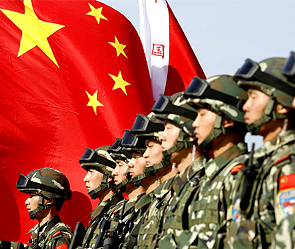
We will not now go into the arguments over who should be more afraid of who, just note that since the death of Chairman Mao quite some time has passed and the world changed once again. At any rate, crowds of Red Guards no long walk the streets of Beijing.
China is now on the rise. Its economy is growing at a rapid pace, technology levels are rapidly increasing, the Chinese armed forces’ efficiency is growing, Chinese foreign expansion is also growing and is associated with the search for new and cheap resources. Despite all the assurances by the Chinese government of its peace-loving nature, China has a powerful military organization and this fact should cause some apprehension.
Answer the question: “Which countries today have carried out manned space flight?” The answer is Russia, the United States and China. Many countries have plans and programs for manned spaceflight: the United States, Europe, India and others, however they all use the services ofNASA, the Russian Space Agency and the National Space Administration of China.
China has its own navigation system Beidou, which is not yet global, but will be by 2020. There should be no doubts about this because China, unlike the European Union and the United States, has no economic problems. In 2011, the Celestial Empire launched its first space station – Tiangong – and has already tested docking it with the Shenzhou manned spacecraft.
Rocket technology is now the primary means of delivering nuclear weapons. Progress in this area is a reflection of the military power of a country aspiring to conduct independent policies. With the help of aircraft carriers a country can control the world’s trade routes and control the governments of natural-resources-producing, quasi-colonial countries. Meanwhile, when, for example, Pyongyang launches another missile, and not even an intercontinental ballistic missile, quiet hysteria builds in Washington.
This year, China has conducted a second test of ground-based missile defense systems. The first test was held in 2010. According to China’s Ministry of Defense, the ground-based missile interception exercise was purely defensive and not directed against any other country. It is interesting that they coincided with interceptor missile trials in the United States as part of the creation of ground-based missile defense system to intercept ballistic missiles while in the middle segment of their flight trajectory (Ground-Based Midcourse Defense, or GMD).
Another important indicator of the country’s military power is the state of its aircraft and air defenses. What is an army without air support? Nothing. If during the Second World War the strike capabilities of assault aircraft bombers were still relatively low, now any attempt by infantry “to dig in and take cover” are not very promising. So what do we observe today? At the moment, the only fifth-generation fighter in service is the F-22 Raptor. The following aircraft are undergoing flight tests: F-35 (U.S.A.), the PAK FA (Russia), ATD-X Shinshin (Japan) and, of course, the Chinese J-20.
While China is not a technology leader in the aviation field, it compensates for many of its deficiencies by copying and technical espionage, but this is only for the time being. The Chinese government’s financing of its own military-technical designs can confidently be called generous.
In short, the success of China’s military development and the rapid technological improvement of its armed forces are undeniable and substantial. However, some intellectuals believe that the main danger emanating from China is its large population. It is scary to note that China has a population of 1.359 billion.
Konstantin Penzev, a writer, historian and columnist exclusively for the online magazine “New Eastern Outlook”.
You can find Part 2 on the following link.